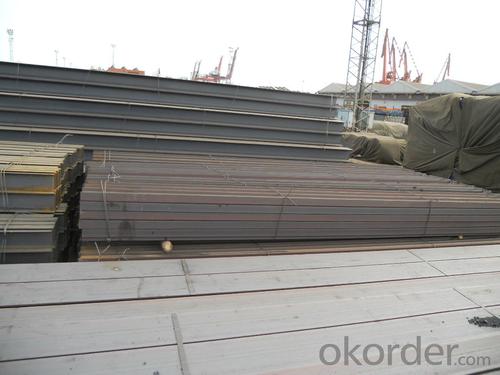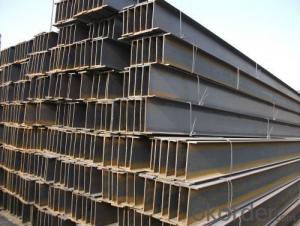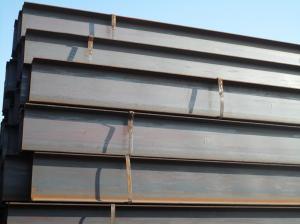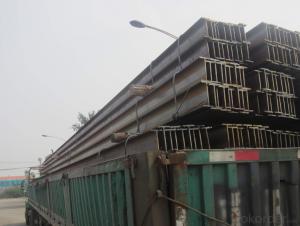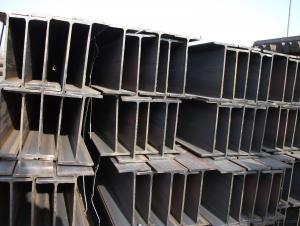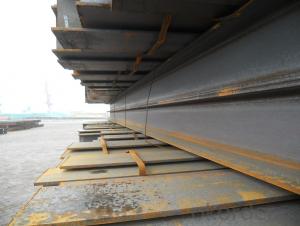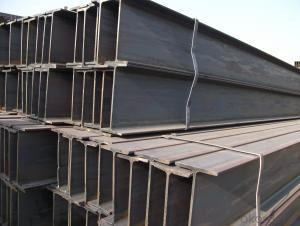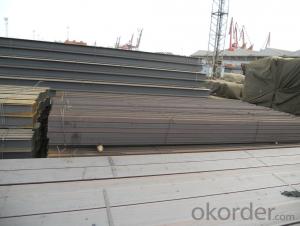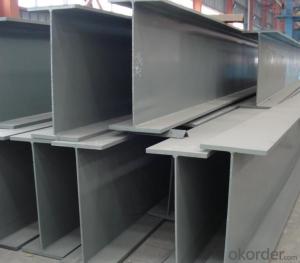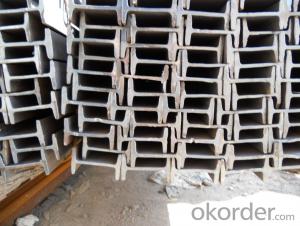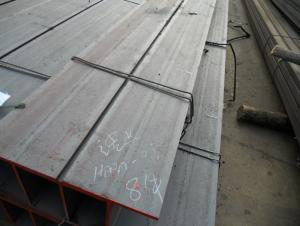JIS Standard Hot Rolled JIS Steel H-Beam
- Loading Port:
- China Main Port
- Payment Terms:
- TT or LC
- Min Order Qty:
- -
- Supply Capability:
- -
OKorder Service Pledge
OKorder Financial Service
You Might Also Like
Product Description:
OKorder is offering high quality Hot Rolled Steel I-Beams at great prices with worldwide shipping. Our supplier is a world-class manufacturer of steel, with our products utilized the world over. OKorder annually supplies products to European, North American and Asian markets. We provide quotations within 24 hours of receiving an inquiry and guarantee competitive prices.
Product Applications:
Commercial building structure ;Pre-engineered buildings; Machinery support structure; Prefabricated structure; Medium scale bridges; Ship-building structure. etc.
Product Advantages:
OKorder's Steel I-Beams are durable, strong, and resist corrosion.
Main Product Features:
· Premium quality
· Prompt delivery & seaworthy packing (30 days after receiving deposit)
· Corrosion resistance
· Can be recycled and reused
· Mill test certification
· Professional Service
· Competitive pricing
Product Specifications:
Manufacture: Hot rolled
Grade: Q195 – 235
Certificates: ISO, SGS, BV, CIQ
Length: 6m – 12m, as per customer request
Packaging: Export packing, nude packing, bundled
| H BEAM | ||||||
| size | h (MM) | b (MM) | t1 (MM) | t2 (MM) | Mass: Kg/m | LENGTH |
| 100x100 | 100 | 100 | 6.0 | 8 | 16.9 | 12M |
| 125x125 | 125 | 125 | 6.5 | 9 | 23.6 | 12M |
| 150x75 | 150 | 75 | 5.0 | 7 | 14.0 | 12M |
| 148x100 | 148 | 100 | 6.0 | 9 | 20.7 | 12M |
| 150x150 | 150 | 150 | 7.0 | 10 | 31.1 | 12M |
| 175x90 | 175 | 90 | 5.0 | 8 | 18.0 | 12M |
| 175x175 | 175 | 175 | 5.0 | 11 | 40.4 | 12M |
| 198x99 | 198 | 99 | 4.5 | 7 | 17.8 | 12M |
| 200x100 | 200 | 100 | 5.5 | 8 | 20.9 | 12M |
| 194x150 | 194 | 150 | 6.0 | 9 | 29.9 | 12M |
| 200x200 | 200 | 200 | 8.0 | 12 | 49.9 | 12M |
| 200x204 | 200 | 204 | 12.0 | 12 | 56.2 | 12M |
| 248x124 | 248 | 124 | 5.0 | 8 | 25.1 | 12M |
| 250x125 | 250 | 125 | 6.0 | 9 | 29.0 | 12M |
| 244x175 | 244 | 175 | 7.0 | 11 | 43.6 | 12M |
| 250x250 | 250 | 250 | 9.0 | 14 | 71.8 | 12M |
| 250x255 | 250 | 255 | 14.0 | 14 | 81.6 | 12M |
| 298x149 | 298 | 149 | 5.5 | 8 | 32.0 | 12M |
| 300x150 | 300 | 150 | 6.5 | 9 | 36.7 | 12M |
| 294x200 | 294 | 200 | 8.0 | 12 | 55.8 | 12M |
| 294x302 | 294 | 302 | 12.0 | 12 | 83.4 | 12M |
| 300x300 | 300 | 300 | 10.0 | 15 | 93.0 | 12M |
| 300x305 | 300 | 305 | 15.0 | 15 | 105.0 | 12M |
| 346x174 | 346 | 174 | 6.0 | 9 | 41.2 | 12M |
| 350x175 | 350 | 175 | 7.0 | 11 | 49.4 | 12M |
| 340x250 | 340 | 250 | 9.0 | 14 | 78.1 | 12M |
| 344x348 | 344 | 348 | 10.0 | 16 | 113.0 | 12M |
| 350x350 | 350 | 350 | 12.0 | 19 | 135.0 | 12M |
| 396x199 | 396 | 199 | 7.0 | 11 | 56.1 | 12M |
| 400x200 | 400 | 200 | 8.0 | 13 | 65.4 | 12M |
| 400x300 | 400 | 300 | 10.0 | 16 | 105 | 12M |
| 388x402 | 388 | 402 | 15.0 | 15 | 140 | 12M |
| 394x398 | 394 | 398 | 11.0 | 18 | 147 | 12M |
| 400x400 | 400 | 400 | 13.0 | 21 | 172 | 12M |
| 400x408 | 400 | 408 | 21.0 | 21 | 197 | 12M |
| 414x405 | 414 | 405 | 18 | 28 | 232 | 12M |
| 428x407 | 428 | 407 | 20 | 35 | 283 | 12M |
| 458x417 | 458 | 417 | 30 | 50 | 415 | 12M |
| 498x432 | 498 | 432 | 45 | 70 | 605 | 12M |
| 446x199 | 446 | 199 | 8 | 12 | 65.1 | 12M |
| 450x200 | 450 | 200 | 9 | 14 | 74.9 | 12M |
| 440x300 | 440 | 300 | 11 | 18 | 121 | 12M |
| 496x199 | 496 | 199 | 9 | 14 | 77.9 | 12M |
| 500x200 | 500 | 200 | 10 | 16 | 88.2 | 12M |
| 506x201 | 506 | 201 | 11 | 19 | 102 | 12M |
| 482x300 | 482 | 300 | 11 | 15 | 111 | 12M |
| 488x300 | 488 | 300 | 11 | 18 | 125 | 12M |
| 596x199 | 596 | 199 | 10 | 15 | 92.5 | 12M |
| 600x200 | 600 | 200 | 11 | 17 | 103 | 12M |
| 606x201 | 606 | 201 | 12 | 20 | 118 | 12M |
| 582x300 | 582 | 300 | 12 | 17 | 133 | 12M |
| 588x300 | 588 | 300 | 12 | 20 | 147 | 12M |
| 594x302 | 594 | 302 | 14 | 23 | 170 | 12M |
| 692x300 | 692 | 300 | 13 | 20 | 163 | 12M |
| 700x300 | 700 | 300 | 13 | 24 | 182 | 12M |
| 792x300 | 792 | 300 | 14 | 22 | 188 | 12M |
| 800x300 | 800 | 300 | 14 | 26 | 207 | 12M |
| 890x299 | 890 | 299 | 15 | 23 | 210 | 12M |
| 900x300 | 900 | 300 | 16 | 28 | 240 | 12M |
| 912x302 | 912 | 302 | 18 | 34 | 283 | 12M |
FAQ:
Q1: Why buy Materials & Equipment from OKorder.com?
A1: All products offered byOKorder.com are carefully selected from China's most reliable manufacturing enterprises. Through its ISO certifications, OKorder.com adheres to the highest standards and a commitment to supply chain safety and customer satisfaction.
Q2: Can stainless steel rust?
A2: Stainless does not "rust" as you think of regular steel rusting with a red oxide on the surface that flakes off. If you see red rust it is probably due to some iron particles that have contaminated the surface of the stainless steel and it is these iron particles that are rusting. Look at the source of the rusting and see if you can remove it from the surface.
Q3: How soon can we receive the product after purchase?
A3: Within three days of placing an order, we will begin production. The specific shipping date is dependent upon international and government factors, but is typically 7 to 10 workdays.
Images:
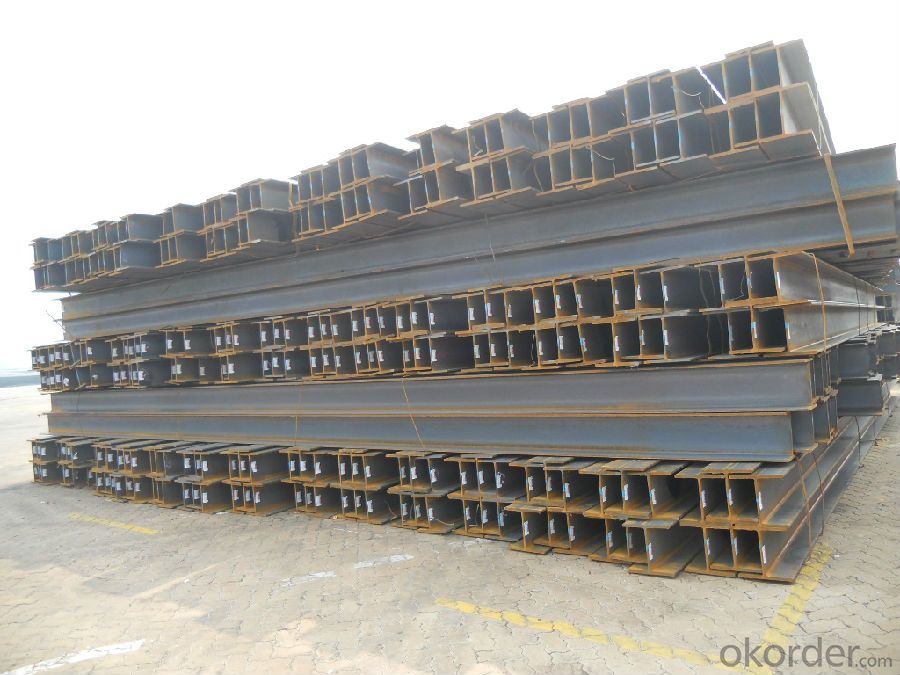
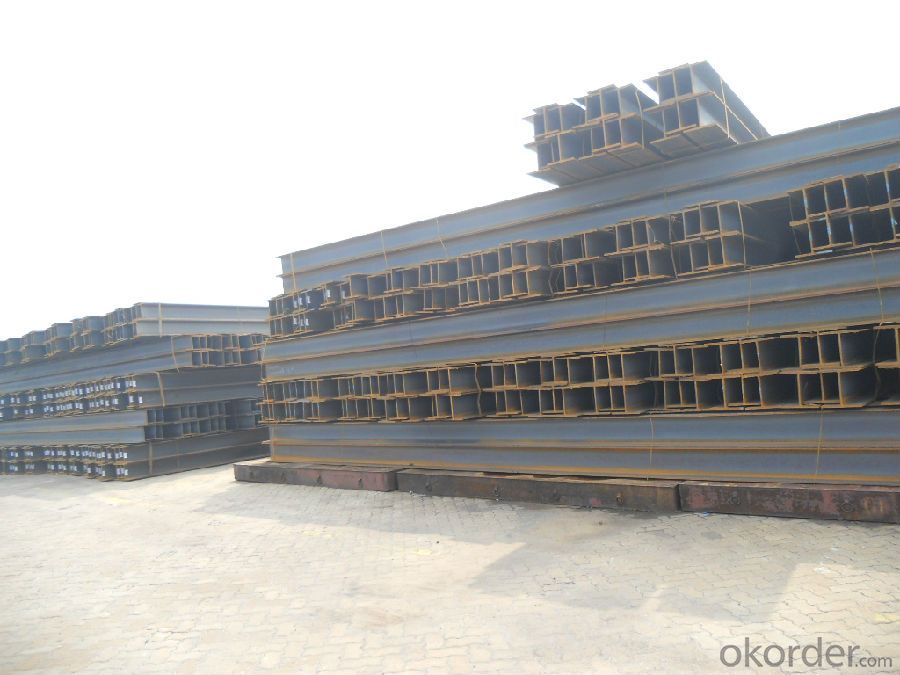
- Q: Can Steel H-Beams be used in data center or IT facility construction?
- Yes, Steel H-Beams can be used in data center or IT facility construction. They provide structural support, stability, and can withstand heavy loads, making them a suitable choice for constructing the framework of these facilities.
- Q: Can steel H-beams be used for hospitals?
- Yes, steel H-beams can be used for hospitals. Steel H-beams are commonly used in construction projects, including hospitals, due to their strength, durability, and ability to support heavy loads. They provide structural integrity and can be used for various applications such as framing, support columns, and beams in hospital buildings.
- Q: Can steel H-beams be used in utility infrastructure projects?
- Yes, steel H-beams can be used in utility infrastructure projects. They are commonly used in bridges, buildings, and other structures due to their strength, durability, and ability to support heavy loads. In utility projects, H-beams can be utilized for constructing support structures, such as transmission towers or substations, where strength and stability are crucial.
- Q: What are the common methods for joining steel H-beams in construction?
- There are several common methods for joining steel H-beams in construction. 1. Welding: This is the most common method used to join steel H-beams. The beams are aligned and welded together using either arc welding or gas welding techniques. Welding provides a strong and durable connection between the beams, ensuring structural integrity. 2. Bolted Connections: Another method is to use bolts to connect the steel H-beams. Holes are drilled into the flanges of the beams, and bolts are inserted through these holes and tightened using nuts. This method allows for easy disassembly and reassembly if needed. 3. Riveting: Riveting involves using rivets to join the steel H-beams. Holes are drilled into the flanges and web of the beams, and rivets are inserted through these holes and then hammered or pressed to secure them. Riveting was a commonly used method in the past, but it has been largely replaced by welding and bolted connections due to its time-consuming nature. 4. Adhesive Bonding: In some cases, adhesive bonding can be used to join steel H-beams. High-strength adhesives are applied to the surfaces of the beams, and they are then pressed together. This method is not as commonly used as welding or bolted connections, but it can be a viable option in certain situations. Overall, welding and bolted connections are the most commonly used methods for joining steel H-beams in construction. These methods provide strong and reliable connections, ensuring the stability and integrity of the structure.
- Q: Can Steel H-Beams be used in historical or heritage restoration projects?
- Yes, Steel H-Beams can be used in historical or heritage restoration projects. Steel H-Beams are versatile and strong structural elements that can provide support and stability to buildings, especially when restoring or reinforcing historic structures. They can be used to replace or reinforce deteriorated or damaged wooden beams, offering increased structural integrity while preserving the historical character of the building. Additionally, Steel H-Beams can be designed to match the original architectural aesthetics, ensuring a seamless integration into the existing structure. However, it is important to consult with preservation specialists and adhere to local heritage regulations to ensure that the use of Steel H-Beams aligns with the principles of historical preservation.
- Q: Can steel H-beams be used in temporary structures?
- Indeed, temporary structures can incorporate steel H-beams. In construction, H-beams are renowned for their robustness, endurance, and adaptability. They are frequently employed in the assembly of temporary structures like scaffolding, temporary bridges, or supportive frameworks for temporary stages or platforms. The exceptional load-bearing capacity of steel H-beams ensures stability and structural soundness in temporary structures. Furthermore, their modular configuration facilitates effortless assembly and disassembly, rendering them exceptionally well-suited for temporary purposes.
- Q: What are the deflection limits for steel H-beams?
- The deflection limits for steel H-beams typically vary depending on the specific design requirements and the application of the beam. However, in general, the deflection limits for steel H-beams are typically specified as a maximum allowable deflection ratio, such as L/360 or L/500, where L represents the span length of the beam. These limits ensure that the deflection of the beam under loading remains within acceptable limits to maintain structural integrity and prevent excessive deformation.
- Q: Are steel H-beams compatible with different construction materials?
- Yes, steel H-beams are compatible with different construction materials. Due to their versatility and strength, steel H-beams can be used in a wide range of construction projects and are compatible with various materials such as concrete, wood, and masonry. They can be used as structural support elements in building frames, bridges, and other infrastructure projects. The ability of steel H-beams to withstand heavy loads and provide stability makes them a preferred choice for combining with different construction materials in various applications.
- Q: Can Steel H-Beams be used for supporting heavy machinery or equipment?
- Yes, Steel H-Beams can be used for supporting heavy machinery or equipment. Steel H-Beams are designed to provide structural support and are commonly used in construction and industrial applications. They have high strength and durability, making them suitable for bearing heavy loads. H-Beams are often used in the construction of bridges, buildings, and other structures that require substantial support. Additionally, their wide flanges and strong web enable them to distribute weight evenly, making them ideal for supporting heavy machinery or equipment. However, it is essential to consider the specific weight and load-bearing requirements of the machinery or equipment in question and consult with a structural engineer to ensure that the chosen H-Beam is appropriate for the intended application.
- Q: How are steel H-beams connected to other structural elements?
- Steel H-beams are commonly connected to other structural elements using various methods such as welding, bolting, or using specialized connectors.
Send your message to us
JIS Standard Hot Rolled JIS Steel H-Beam
- Loading Port:
- China Main Port
- Payment Terms:
- TT or LC
- Min Order Qty:
- -
- Supply Capability:
- -
OKorder Service Pledge
OKorder Financial Service
Similar products
Hot products
Hot Searches
Related keywords



